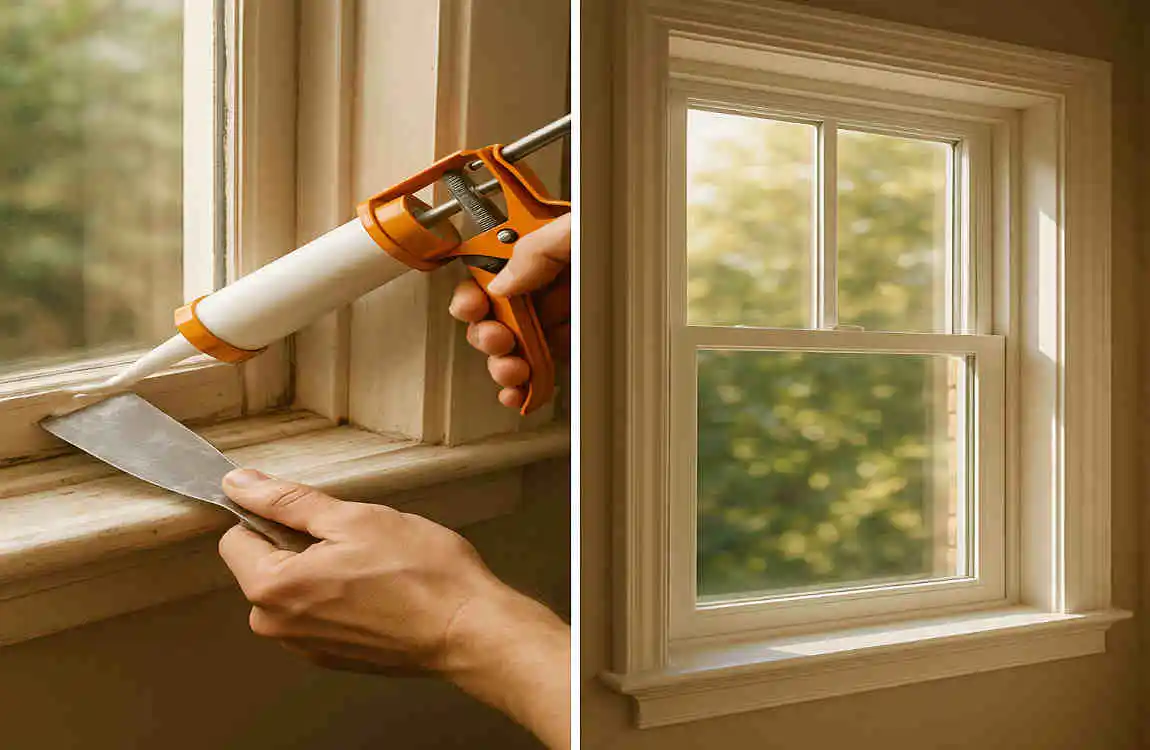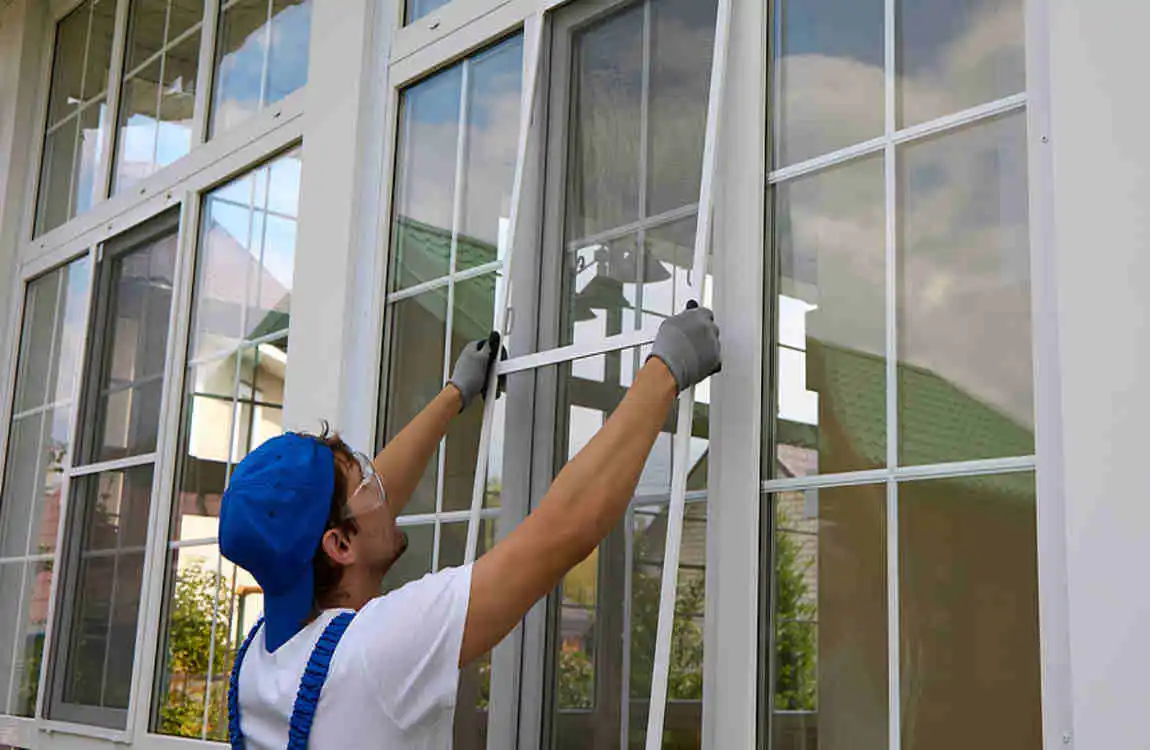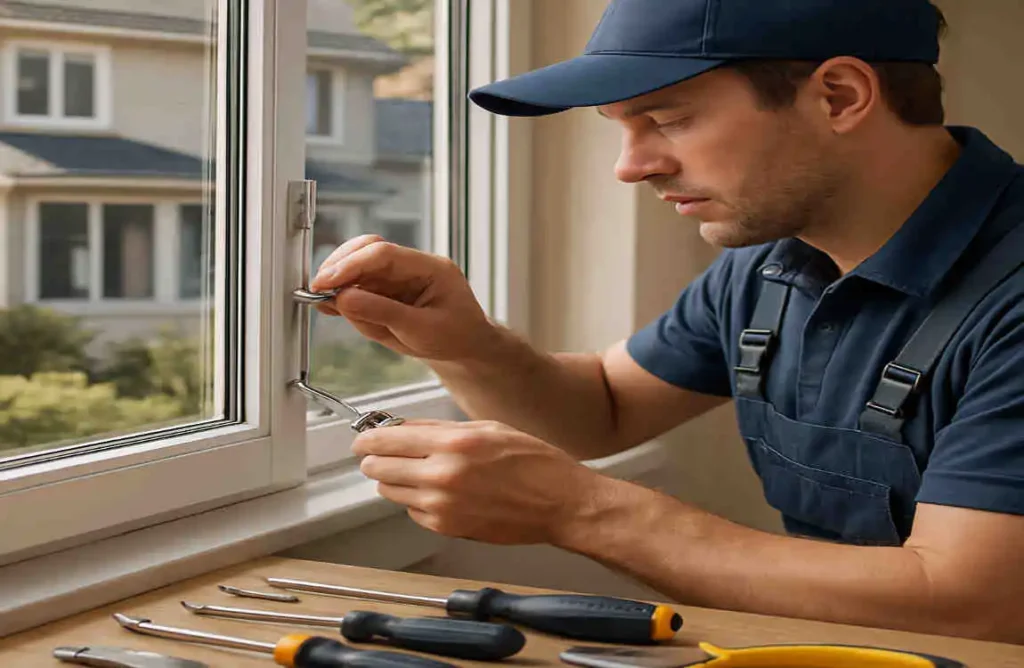Have you ever looked at your windows and wondered if they could be better? Your home’s windows play a crucial role in maintaining its value, energy efficiency, and overall comfort. But what happens when they start to show signs of wear and tear? This brings us to the pressing question: can home windows be repaired?
Understanding Home Window Repairs: Can Home Windows Be Repaired?

Typical Window Problems
Before we can answer the question of whether home windows can be repaired, let’s first take a look at some of the most common issues you might encounter:
- Cracks: These can range from minor hairline fractures to significant, jagged breaks.
- Foggy Glass: Double-paned windows can develop condensation between the panes, causing a foggy appearance.
- Damaged Frames: Wood, vinyl, and aluminum frames can all suffer from various forms of damage, including rot, warping, and cracks.
- Broken Seals: The seals around your windows can deteriorate over time, leading to air leaks and reduced energy efficiency.
Types of Windows and Repairability
The type of window you have can also impact its repairability. Here are some of the most common types of windows found in homes:
- Single- or Double-Hung Windows: These traditional windows have sashes that slide up and down. They can often be repaired, depending on the extent of the damage.
- Casement Windows: These windows are hinged on one side and open outward. They may require more specialized repairs, especially if the hinges are damaged.
- Sliding Windows: Similar to single- or double-hung windows, sliding windows move horizontally. Repairs can vary depending on the type of damage.
- Fixed Windows: These non-opening windows are generally easier to repair, as they don’t have moving parts.
Repairable vs. Replaceable Issues
Now, let’s address the burning question: can home windows be repaired? The answer is a resounding yes, but it depends on the specific issue at hand. Some problems, like small cracks or damaged hardware, can often be fixed with a simple repair. Others, such as extensive frame rot or severe structural damage, may require a complete window replacement.
In the next section, we’ll dive deeper into the common window problems that can be repaired and how to tackle them.
Common Window Problems That Can Be Repaired
Cracked or Broken Panes
Cracks and breaks in window panes are some of the most common issues homeowners face. But when it comes to repairing them, the approach can vary:
- Small Cracks: For minor cracks, you can use a glass repair kit to fill and seal the damage. This can be a cost-effective solution for non-structural cracks.
- Large Cracks or Breaks: In cases of more significant damage, it’s usually best to replace the entire pane. This ensures the structural integrity of your window and prevents further issues.
Foggy or Condensation-Filled Double Panes
If you have double-paned windows and notice fog between the panes, it’s likely due to a broken seal. Here’s what you can do:
- Seal Replacement: In some cases, a professional can replace the seal between the panes, restoring clarity to your window.
- Complete Pane Replacement: If the seal cannot be repaired or if the glass is damaged, replacing the entire pane may be necessary.
Damaged Window Frames
The material of your window frame can impact the repair process:
- Wood Frames: Wood frames can often be repaired by patching and refinishing damaged areas. This can be a cost-effective solution for minor damage.
- Vinyl Frames: Vinyl frames are more challenging to repair, but small cracks or holes can sometimes be filled with a specialized vinyl repair compound.
- Aluminum Frames: Aluminum frames are generally the most difficult to repair, but minor dents or scratches can sometimes be fixed with specialized tools and techniques.
Broken Locks and Hardware Replacement
If your window locks or hardware are damaged, you may be able to replace them yourself:
- Locks: Many window locks can be easily replaced with a new unit from a hardware store. Just make sure to match the size and style of your existing lock.
- Hardware: Other hardware, such as handles or hinges, can also be replaced if they become damaged or worn out.
Weatherstripping and Sealing Repair
Proper weatherstripping and sealing are essential for maintaining energy efficiency:
- Weatherstripping: If your weatherstripping is damaged or worn, replace it with new strips to prevent air leaks.
- Sealing: Gaps around your windows can be sealed with caulk or weatherproofing tape to improve insulation and reduce drafts.
When Repair Isn’t Enough: Signs You Should Replace Your Windows
While many window issues can be repaired, there are certain signs that indicate it may be time for a complete replacement:
Extensive Frame Rot or Warping
If your window frames show signs of extensive rot or warping, it’s likely time to replace them. These issues can compromise the structural integrity of your window and lead to further problems down the line.
Severe Structural Damage
If your window has suffered severe structural damage, such as a broken frame or shattered glass, it’s generally best to replace the entire unit. This ensures the safety and Security of your home.
Persistent Condensation or Air Leaks
If you’ve already attempted repairs but are still experiencing persistent condensation or air leaks, it may be time to consider a replacement. These issues can lead to reduced energy efficiency and increased utility bills.
Cost Analysis Tipping Point
Finally, it’s essential to consider the cost of repairs versus replacement. If the cost of repairing your windows is approaching or exceeding the cost of new windows, it may make more sense to invest in a replacement.
In the next section, we’ll provide a step-by-step guide to home window repairs in 2025, helping you tackle common issues and save money.
Step-by-Step Guide to Home Window Repairs in 2025
Diagnosing the Problem
Before you can start repairing your windows, you need to diagnose the problem. Here are some self-inspection tips to help you get started:
- Visual Inspection: Look for visible signs of damage, such as cracks, chips, or fogginess.
- Touch Test: Run your hand along the window frame and sashes to feel for any gaps or loose areas.
- Air Leak Test: On a windy day, hold a lit candle or an incense stick near the window to detect air leaks.
If you’re unsure about the extent of the damage or feel uncomfortable attempting repairs yourself, it’s always best to call a professional.
Essential Tools and Materials
To tackle common window repairs, you’ll need a few essential tools and materials:
- Safety Gear: Gloves, safety glasses, and a dust mask to protect yourself during the repair process.
- Basic Tools: Screwdrivers, pliers, a utility knife, and a putty knife for removing old caulk or paint.
- Repair Materials: Glass repair kits, replacement weatherstripping, caulk, and wood filler or vinyl repair compound, depending on your window type.
Repairing Glass Panes
If you have a cracked or broken glass pane, here’s how to repair it safely:
- Remove the Damaged Pane: Carefully remove any remaining glass shards and clean the frame.
- Measure and Cut: Measure the opening and cut a new piece of glass to fit.
- Install the New Pane: Apply a bead of glazing compound around the frame, then press the new glass into place.
- Secure and Seal: Use glazier’s points to secure the glass, then apply more glazing compound to seal the edges.
Fixing and Replacing Window Seals and Weather stripping
To improve energy efficiency and prevent drafts, follow these steps to repair or replace your window seals and weathers tripping:
- Remove Old Seals: Use a putty knife or utility knife to carefully remove any old, damaged seals or weather stripping.
- Clean the Surface: Thoroughly clean the area where the new seal or weather stripping will be applied.
- Apply New Seals: Cut the new seal or weather stripping to size, then press it firmly into place to ensure a tight seal.
Frame Patching and Refinishing
If your window frame is damaged, you can patch and refinish it to restore its appearance and functionality:
- Assess the Damage: Determine the extent of the damage and whether it can be repaired or requires replacement.
- Remove Damaged Areas: Use a chisel or utility knife to carefully remove any rotten or damaged wood.
- Apply Wood Filler: Fill the damaged areas with a suitable wood filler, allowing it to dry completely.
- Sand and Refinish: Sand the repaired areas smooth, then apply a primer and paint or stain to match the rest of the frame.
Hardware Replacement and Adjustments
If your window hardware is damaged or malfunctioning, you may need to replace or adjust it:
- Locks and Handles: Remove the old lock or handle and Install a new one, ensuring it’s properly aligned and secure.
- Hinges: If your hinges are loose or damaged, tighten the screws or replace the hinges entirely.
When to Hire a Licensed Window Repair Specialist
While many window repairs can be tackled as a DIY project, there are times when it’s best to hire a licensed professional:
- Extensive Damage: If your windows have sustained extensive damage or you’re unsure of the extent of the repairs needed, a professional can provide a thorough assessment and recommend the best course of action.
- Safety Concerns: If you’re uncomfortable working with glass or at heights, it’s always safer to leave the repairs to a trained professional.
- Warranty Concerns: If your windows are still under warranty, attempting DIY repairs could void the warranty. In this case, it’s best to contact the manufacturer or a certified repair specialist.
In the next section, we’ll break down the costs associated with window repairs in 2025, helping you budget for your project and make informed decisions.
Cost Breakdown: How Much Does Window Repair Cost in 2025?
Average Cost Ranges
The cost of window repairs can vary depending on the type of repair needed and the extent of the damage. Here are some average cost ranges for common repairs in 2025:
- Glass Replacement: $100- $300 per pane, depending on the size and type of glass.
- Sealing and Weather stripping: $50-$150 per window, depending on the size and complexity of the job.
- Frame Repair: $100- $300 per window, depending on the material and the extent of the damage.
- Hardware Fixes: $25-$100 per window, depending on the type of hardware and the complexity of the repair.
Factors Influencing Repair Costs
Several factors can influence the cost of window repairs:
- Window Type: The type of window you have can affect repair costs. For example, repairing a casement window may be more expensive than fixing a single-hung window.
- Extent of Damage: The more extensive the damage, the higher the repair costs are likely to be.
- Labor Costs: Labor costs can vary by location and the experience level of the repair specialist.
- Materials: The cost of replacement glass, seals, weatherstripping, and other materials can also impact the overall repair cost.
Cost Comparison: Repairing vs. Replacing
When deciding whether to repair or replace your windows, it’s essential to consider the costs involved. Here’s a brief comparison:
- Repair Costs: As mentioned earlier, repair costs can range from $50 to $300 per window, depending on the type of repair needed.
- Replacement Costs: The cost to replace a window can range from $300 to $1,000 or more, depending on the type, size, and material.
In general, if the cost of repairs approaches or exceeds the price of a new window, it may be more cost-effective to replace the window.
Budgeting Tips for Homeowners
To help you budget for your window repairs, consider these tips:
- Get Multiple Quotes: Don’t settle for the first quote you receive. Get multiple quotes from different repair specialists to ensure you’re getting the best price.
- Prioritize Repairs: If you have multiple windows that need attention, prioritize them based on the extent of the damage and their impact on your home’s energy efficiency.
- Consider DIY: For minor repairs, consider tackling the job yourself to save on labor costs. Just be sure to follow safety guidelines and use the proper tools and materials.
- Plan for the Future: When budgeting for window repairs, consider the long-term benefits of investing in energy-efficient solutions and innovative technologies to help you save on utility bills.
In the next section, we’ll explore the latest innovative technologies and solutions revolutionizing window repairs in 2025.
Smart Tech and Solutions Revolutionizing Window Repairs in 2025

Overview of Smart Window Technologies and Materials
The world of window repairs is being transformed by cutting-edge smart technologies and innovative materials. These advancements are making it easier than ever to maintain and repair your windows, while also improving energy efficiency and sustainability.
Self-Healing Glass and Modern Sealants
One of the most exciting developments in window repair technology is the introduction of self-healing glass. This revolutionary material can automatically repair minor scratches and cracks, extending the life of your windows and reducing the need for costly repairs.
In addition to self-healing glass, modern sealants are also making a significant impact on window repairs. These advanced sealants are more durable and long-lasting than traditional options, helping to prevent air leaks and improve energy efficiency.
Smart Sensors for Window Damage and Energy Loss Detection
Another game-changing technology in window repair is the use of smart sensors. These sensors can detect even the most minor signs of window damage or energy loss, alerting you to potential issues before they become significant problems.
By installing smart sensors on your windows, you can stay one step ahead of repairs and proactively maintain your home’s energy efficiency. These sensors can also help you identify which windows need attention first, allowing you to prioritize your repairs and budget accordingly.
Energy-Efficient Window Repair Solutions and Upgrades
In 2025, energy efficiency is more important than ever, and window repairs are no exception. When repairing your windows, consider upgrading to energy-efficient solutions to save money on utility bills and reduce your carbon footprint.
Some popular energy-efficient window repair options include:
- Low-E Glass: This special type of glass has a thin coating that reflects heat, helping keep your home warmer in winter and cooler in summer.
- Argon Gas Fills: By filling the space between double-paned windows with argon gas, you can improve insulation and reduce heat transfer.
- Smart Window Films: These innovative films can be applied to your existing windows to improve energy efficiency and reduce glare.
Eco-Friendly Repair Materials and Sustainable Practices
As we move towards a more sustainable future, eco-friendly repair materials and practices are becoming increasingly crucial in window repair.
When choosing repair materials, look for options that are made from recycled or renewable resources, such as bamboo or reclaimed wood. These materials not only reduce your environmental impact but can also add a unique, eco-friendly touch to your home.
In addition to using sustainable materials, consider working with repair specialists who prioritize eco-friendly practices, such as proper waste disposal and energy-efficient repair techniques.
By embracing innovative technologies, energy-efficient solutions, and eco-friendly practices, you can revolutionize the way you approach window repairs in 2025. These innovations not only make repairs easier and more effective but also help you create a more sustainable and energy-efficient home.
In the next section, we’ll explore how to choose the right window repair company and what to look for when hiring a professional.
Choosing the Right Window Repair Company: What to Look For
Licensing, Insurance, and Certifications
When hiring a window repair company, one of the most important factors to consider is their licensing, insurance, and certifications. A reputable company should have all the necessary licenses and insurance to operate in your area, as well as relevant certifications that demonstrate their expertise in window repairs.
Before hiring a company, be sure to request proof of their licensing and insurance, and check for certifications from organizations such as the National Fenestration Rating Council (NFRC) or the American Architectural Manufacturers Association (AAMA).
Reviews and Testimonials
Another crucial aspect to consider when choosing a window repair company is its reputation. Look for reviews and testimonials from past customers to gauge the quality of their work, customer service, and overall satisfaction.
You can find reviews on the company’s website, social media pages, or third-party review sites like Yelp or Google. Pay attention to both positive and negative reviews, and look for patterns or recurring themes that can help you make an informed decision.
Guarantees and Warranties
A reputable window repair company should stand behind its work with guarantees and warranties. Before hiring a company, ask about their warranty policy and what it covers. A good warranty should cover both the labor and materials used in the repair and last for a reasonable period.
Some companies may also offer guarantees on their work, promising to fix any issues that arise within a specific period after the repair. This can give you added peace of mind and protection for your investment.
Services Offer
When choosing a window repair company, consider the range of services they offer. A comprehensive company should be able to handle a wide variety of window repairs, from simple glass replacement to more complex frame repairs and hardware fixes.
Some companies may also offer additional services, such as emergency repairs, regular maintenance packages, or even window replacement if needed. Consider your specific needs and look for a company that can provide the services you require.
